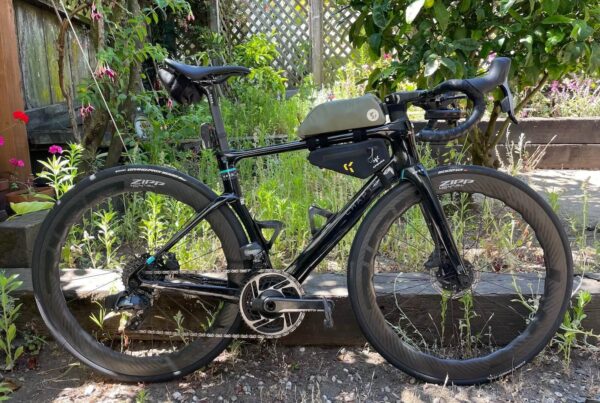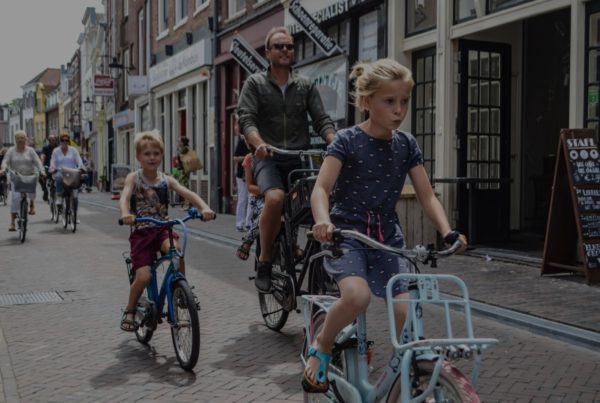In September, I wrote about an enforcement action jointly conducted between the Los Angeles Police Department and the University of Southern California Department of Public Safety. Their target? Law-abiding cyclists who are legally riding within crosswalks. Despite the law-abiding nature of the behavior that has been targeted, the LAPD invented a non-existent “law” prohibiting riding in the crosswalk, and began slapping USC students with tickets carrying a $250 fine.
Not to be outdone by their next-door brethren, a reader in California informs us that the Redondo Beach Police Department has been ticketing cyclists for riding two abreast:
This morning a group of six friends were cited by a Redondo Beach officer for ‘not riding single file.’ I don’t know what statute specifically the officer listed on the citation. My friends tell me they were riding two abreast on a wide road with next to no traffic. I ride with these folks often and typically when a car approaches from the rear, someone shouts out ‘car back’ and we move to single file and press closer to the curb. I’d be amazed if they were impeding traffic in any way.
When issuing the tickets, the cop stated that ‘single file is the law’ and added they ticketed 30 riders the preceding weekend.
Reading the statute concerning bicycles I see no specific clause prohibiting riding two abreast. But one could infer from the ‘as far to the right as practicable’ clause that if there’s a rider to your right then you are not over far enough.
It’s seems that there’s a common perception that single file is indeed the law and I’m wondering how the court most often decides when the tickets for not ‘riding single file’ are challenged. I’d think that as lane sharing is permitted that as a practical matter only the rider to the left would be ‘not as for to the right as possible.’
I’m hoping to convince one of buddies to challenge the ticket, if only to inform the officer. Redondo is notorious for these crackdowns while ignoring numerous dooring incidents.
So is it true, as the Redondo Beach police officer has been asserting, that “single file is the law”? Absolutely not. There is no statute in California that explicitly requires cyclists to ride single file. However, there is also no statute in California that explicitly permits cyclists to ride two or more abreast. Instead, the law is more nuanced in regards to cyclists riding two abreast. Under some circumstances, cyclists may ride two or more abreast; under other circumstances, cyclists must ride single file.
The starting place for understanding the nuances of California law regarding riding two abreast is the statute that dictates when cyclists must ride to the right:
Any person operating a bicycle upon a roadway at a speed less than the normal speed of traffic moving in the same direction at that time shall ride as close as practicable to the right-hand curb or edge of the roadway…
Following this basic requirement, the statute lists several safety exceptions to the general rule. Those safety exceptions aside, if a group of cyclists is riding at less than the “normal speed of traffic moving in the same direction at that time,” the statute can be reasonably read as requiring each cyclist in the group to ride as close to the right as practicable, because unlike other states, California does not explicitly allow cyclists to ride two abreast.
However, when a cyclist is riding at the “normal speed of traffic moving in the same direction at that time,” California law allows the cyclist to ride in any position in any lane. And that raises a couple of issues for cyclists.
First, what does the law mean by the “normal speed of traffic”? Does it mean the speed of motor vehicle traffic? Or does it mean the prevailing speed of all traffic, including cyclists?
Because the statute uses the general term “traffic,” rather than the specific term “motor vehicle traffic,” the law clearly means, among other things, that when cyclists are the only traffic on the road, they are traveling at the “normal speed of traffic.” And thus, under California law, they may legally ride in any position in any lane.
Of course, if approaching motor vehicle traffic is traveling at a faster rate of speed, cyclists may be required to move as close as practicable to the right. Whether cyclists may continue to ride in any lane, or whether they must move right, depends in part on whether California law sets the “normal speed of traffic” by the fastest vehicle on the road, or by the prevailing speed set by the majority of vehicles on the road. The answer, I think, should be obvious—the “normal speed of traffic” is the prevailing speed by the aggregate of all traffic on the road, rather than the fastest driver, or the slowest cyclist on the road. This is true even if the speed limit is higher than the speed at which the aggregate of traffic is traveling, because the basic speed law prohibits vehicle operators from driving at a speed that is greater than appropriate for conditions:
No person shall drive a vehicle upon a highway at a speed greater than is reasonable or prudent having due regard for weather, visibility, the traffic on, and the surface and width of, the highway, and in no event at a speed which endangers the safety of persons or property.
Thus, if a lone motorist approaches a group of cyclists, it is they, and not the lone motorist, who are setting the “normal speed of traffic,” and technically speaking, the law does not require them to ride as close to the right as practicable. However, as a practical matter, a stubborn insistence on adhering to the letter of the law in this situation will only arouse the ire of motorists and law enforcement, so for the sake of common courtesy and good public relations, the best course of action would be to allow the approaching motorist to pass.
On the other hand, if there are more motorists than cyclists on the roadway, it is again the prevailing speed of the aggregate of all traffic on the road, rather than the slowest cyclist, that is setting the “normal speed of traffic,” and the law requires cyclists who are riding at less than the “normal speed of traffic” to ride as close as practicable to the right.
The second issue raised is this: If cyclists can otherwise legally ride in any lane, and if the law does not specifically prohibit cyclists from riding two or more abreast, is there nevertheless something in the law that prohibits them from riding two abreast in the same lane?
No. In fact, the law contemplates that motorists and cyclists will be sharing lanes—thus, the law sometimes requires that cyclists ride as close as practicable to the right. So, if the law does not prohibit cyclists from riding two abreast, and if the law contemplates that motorists and cyclists will be sharing lanes, is there any reason to believe that two cyclists may not share a lane? Of course not. To assert otherwise is to invent non-existent “law” whole cloth from the imagination.
And yet, the law is nuanced in California—sometimes, cyclists may ride two (or more) abreast, while at other times, they must ride single file. The trick for cyclists is to understand when the law allows them to ride two (or more) abreast, and when the law requires them to ride single file. To make it easy to understand, here’s a summary of the law:
For cyclists traveling in a vehicular lane on the roadway:
In California, cyclists may legally ride two or more abreast, as long as they are traveling at the “normal speed of traffic,” or if they are traveling in a lane that is too narrow to safely share with a motor vehicle.
However, if the cyclists are not traveling at the “normal speed of traffic,” and the lane is wide enough to safely share with a motor vehicle, then the cyclists must ride single file.
For other situations:
It is legal for cyclists to ride two or more abreast in the following situations:
- When both cyclists are riding on the shoulder
- When both cyclists are riding in a bicycle lane
- When one cyclist is riding on the roadway, and one cyclist is riding on the shoulder.
Now, the other trick for cyclists will be to explain that they are riding within what the law allows to any law enforcement officers who stop them in the mistaken belief that “single file is the law.” Good luck with that one—you may have better luck explaining the law to a traffic court judge.




I’ve sent a link re this posting to Officer Ian Miesen (Community Relations) of the Redondo Beach Police Department, asking for comment.
Cyclists riding in the wide bike lanes and shoulders through Woodside, CA are sometimes harassed by the San Mateo County Sheriff with tickets written for phantom CVC violations.
I received the following email from Office Meisen of the Redondo Beach Police Department.
Hi Jim,
There are a number of elements that come into play when a citation is issued. I am interested in the exact vehicle code the cyclist was cited for, along with the location, time of day etc.
As a Police Officer I’m often approached, both on and off duty, about traffic citations and quizzed about the validity of the citation. Not being the Officer that issued the cite I listen to the other side and refer the violator to follow up in traffic court if they feel the cite is unjust.
The bike provisions are mostly covered in of the vehicle code.
Bicyclist on a highway/roadway are subject to all rules of the road, including stop signs, headsets, lighting, DUIs etc. The vehicle code is available on the web and a search engine will be able to find it for additional reading.
I have not heard of any recent dooring incidents the blog mentioned. If you could forward along any additional information as I am very interested.
In reviewing the Bicycle Provisions of the California Vehicle Code I found the following section on the DMV website that deals with bikes on the
roadway:
Operation on Roadway
21202. (a) Any person operating a bicycle upon a roadway at a speed less than the normal speed of traffic moving in the same direction at that time shall ride as close as practicable to the right-hand curb or edge of the roadway except under any of the following situations:
(1) When overtaking and passing another bicycle or vehicle proceeding in the same direction.
(2) When preparing for a left turn at an intersection or into a private road or driveway.
(3) When reasonably necessary to avoid conditions (including, but not limited to, fixed or moving objects, vehicles, bicycles, pedestrians, animals, surface hazards, or substandard width lanes) that make it unsafe to continue along the right-hand curb or edge, subject to the provisions of Section 21656. For purposes of this section, a “substandard width lane” is a lane that is too narrow for a bicycle and a vehicle to travel safely side by side within the lane.
(4) When approaching a place where a right turn is authorized.
(b) Any person operating a bicycle upon a roadway of a highway, which highway carries traffic in one direction only and has two or more marked traffic lanes, may ride as near the left-hand curb or edge of that roadway as practicable.
Amended Sec. 4, Ch. 674, Stats. 1996. Effective January 1, 1997.
Take care,
Ian M.
Interesting Sidenote
I recently have been looking up municipal codes regarding bicycles on the Internet. Many of the smaller cities (not including Redondo Beach) have an ordinance similar to this ordinance in Torrance:
SECTION 62.1.3. RIDING IN A GROUP.
Persons operating bicycles upon a roadway shall not ride more than two (2) abreast except on paths or parts of roadways set aside for the exclusive use of bicycles.
If riding “more than two (2) abreast ” is illegal, does that not imply that riding two abreast is legal?
The “Interesting Sidenote” posted by David Whiteman gives the text of a Torrance ordinance governing bicycle operation on streets. My understanding is that — because the California Vehicle Code does not authorize local agencies to regulate on-street bicycle operation (as it does sidewalk operation), Torrance’s ordinance probably violates state law. AFAIK, locals may regulate only those things for which state law grants them regulatory authority.
Thanks John (and David). We are actually putting together a new Road Rights article dealing with this issue of local regulation that seems to conflict with state law. We will take a look at the ordinances you mention.
Hi Bob. I’m finding your arguments about what constitutes “normal speed of traffic” and your conclusion “Because the statute uses the general term traffic, rather than the specific term motor vehicle traffic, the law clearly means, among other things, that when cyclists are the only traffic on the road, they are traveling at the normal speed of traffic. And thus, under California law, they may legally ride in any position in any lane,” interesting, but as you know, the law it ultimately means whatever the courts decide it means, so I am wondering if there is any case law from CA, or other states using this same language, that supports your interpretation. I live in a state, Hawaii, that has the same “normal speed of traffic” language and the police have threatened me several times with a ticket for doing what you are arguing is legal, so the police themselves seem to have a different interpretation than you do and, while your argument is clever, without case law to back it up I have no idea whether or not a judge will buy it.